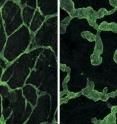Building the lymphatic drainage system
Our bodies' tissues need continuous irrigation and drainage. Blood vessels feeding the tissues bring in the fluids, and drainage occurs via the lymphatic system. While much is known about how blood vessels are built, the same was not true for lymph vessels. Now though, Norrmén et al. have identified two of the lead engineers that direct drainage construction in the mouse embryo. The engineers are the transcription factors, Foxc2 and NFATc1. Foxc2 had been implicated in lymph vessel development already, but Norrmén and colleagues have now found that the factor specifically regulates a late stage of lymph development when large, valve-containing vessels arise from more primitive capillaries. The study will be published online April 27 (www.jcb.org) and will appear in the May 4 print issue of the Journal of Cell Biology.
Foxc2 built the lymph vessel valves with the help of NFATc1, which was a known heart valve engineer. Norrmén and colleagues also showed that Foxc2 and NFATc1 physically interact and that many DNA binding sites for the two transcription factors are closely linked. This latter finding generated a long list of target genes that might be controlled by the two factors.
The team now plans to investigate these targets as well as to work out the upstream molecular pathways controlling Foxc2 and NFATc1. Whatever the mechanisms, if the team can show that Foxc2 and NFATc1 also prompt lymph vessel regeneration in adults, boosting these factors could help patients with lymph drainage problems – including those that have suffered extensive tissue injuries, or have had lymph nodes removed as part of cancer treatment.
Source: Rockefeller University Press
Other sources
- Building The Lymphatic Drainage Systemfrom Science DailyMon, 27 Apr 2009, 13:14:27 UTC
- Building the lymphatic drainage systemfrom PhysorgMon, 27 Apr 2009, 9:35:20 UTC
- Building the lymphatic drainage systemfrom Biology News NetMon, 27 Apr 2009, 6:35:35 UTC
